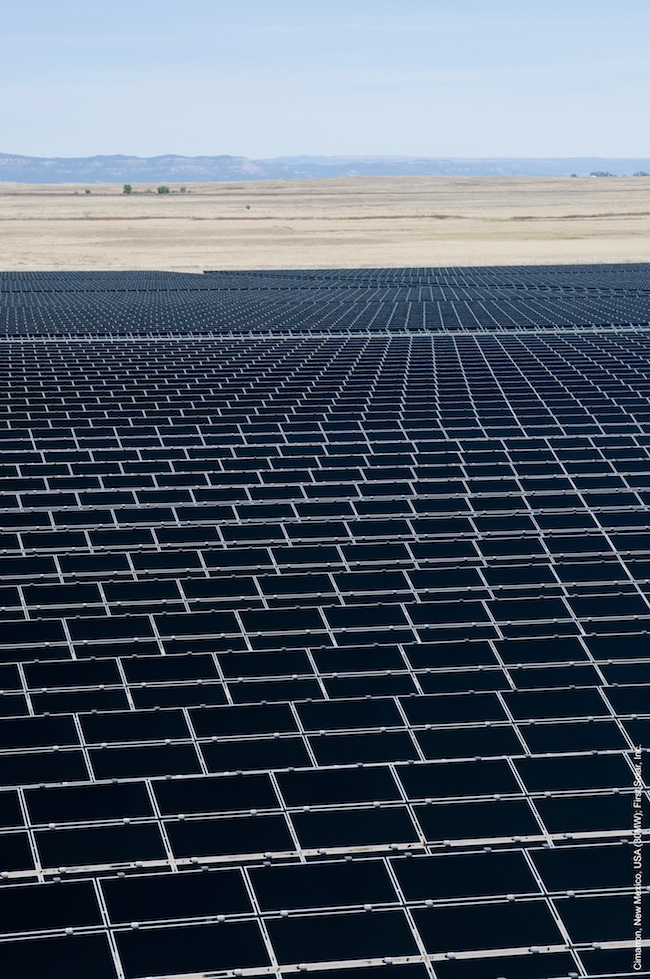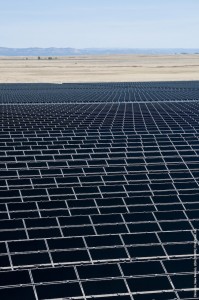
Located in Northern New Mexico, the Cimarron solar facility uses 490,000 ground mounted Cd-Te thin-film solar cells from First Solar to produce up to 30 MW of power. (Credit: First Solar.)
Driven by dramatically decreasing hardware costs, the installed cost of solar photovoltaic systems fell in 2012 and through the first half of this year, according to an annual report from the US Department of Energy’s Lawrence Berkeley National Laboratory (Berkeley, Calif.).
The lab’s “Tracking the Sun” report (pdf) says installed costs for solar power systems in 2012 decreased by $0.30–$0.90 per watt, or 6 to 14 percent compared with 2011, depending on system size.
“This marks the third year in a row of significant price reductions for PV systems in the US,” says report coauthor Galen Barbose of Berkeley’s Environmental Energy Technologies Division, in a news release. System prices in California fell by an additional 10 to 15 percent in the first half of 2013, and the report suggests price reductions in 2013 will match or exceed those seen in recent years.
According to the report, recent cost reductions are due mainly to steep reductions in the price of PV cells—since 2008, average module prices on the global market fell by $2.60/W, or about 80 percent of the total decline in PV system prices over that period. In contrast, prices for inverters, mounting hardware and other system components, plus installation costs, have remained relatively flat over the past few years.
This is a topic we have covered in the past. The question now is, how low can PV cell costs go? Prices of polycrystalline silicon cells—the dominant technology in the solar market—continue to fall, and could eventually go as low as $0.25 per watt, according to a recent report in MIT Technology Review. But the article also outlines progress on a new type of solar cell made from ceramic materials with the perovskite crystal structure.
“Researchers developing the technology say that perovskite-based cells could be both inexpensive to produce and have good efficiency, leading to solar panels that cost just 10 to 20 cents per watt,” the article says. Perovskite PV cells are a thin film technology, and a cell with 1 µm of perovskite material can absorb the same amount of light as silicon cells 180 µm thick, according to the article.
One company working to commercialize perovskite PV cell technology is Oxford Photovoltaics, Begbroke, England. In June, the company announced it had achieved 15.4% efficiency for its perovskite solar cells. According to the MIT article, efficiencies for perovskite cells could eventually reach 20–25 percent.
Another thin film technology competing with polycrystalline silicon is cadmium telluride, and some big players in the solar world are making moves to position themselves in this market.
First Solar Inc., Tempe, Ariz., has been working to develop Cd-Te technology for several years. The company announced last week that it has acquired Cd-Te thin film technology from GE, which will transition from First Solar competitor to investor. The sale gave GE 1.75 million shares of First Solar’s common stock, according to the announcement, and the companies also will purchase each others’ products—First Solar will buy inverters from GE, while the latter will buy PV cells from First Solar.
GE and First Solar had been in a race to improve the efficiency of Cd-Te cells, with First Solar announcing in February that it had produced a laboratory cell with 18.7 percent efficiency at its Perrysburg, Ohio, production and R&D facility. GE followed that up with an announcement of a lab cell with 19.6 percent efficiency, according to a recent article on the technology blog GigaOM.
The business moves highlight the cut-throat nature of competition in the global solar cell market, which prompted GE to stop work on a planned manufacturing plant in Colorado at the end of 2012 and instead partner with First Solar. The companies face stiff competition from Chinese solar cell producers, the article says.

